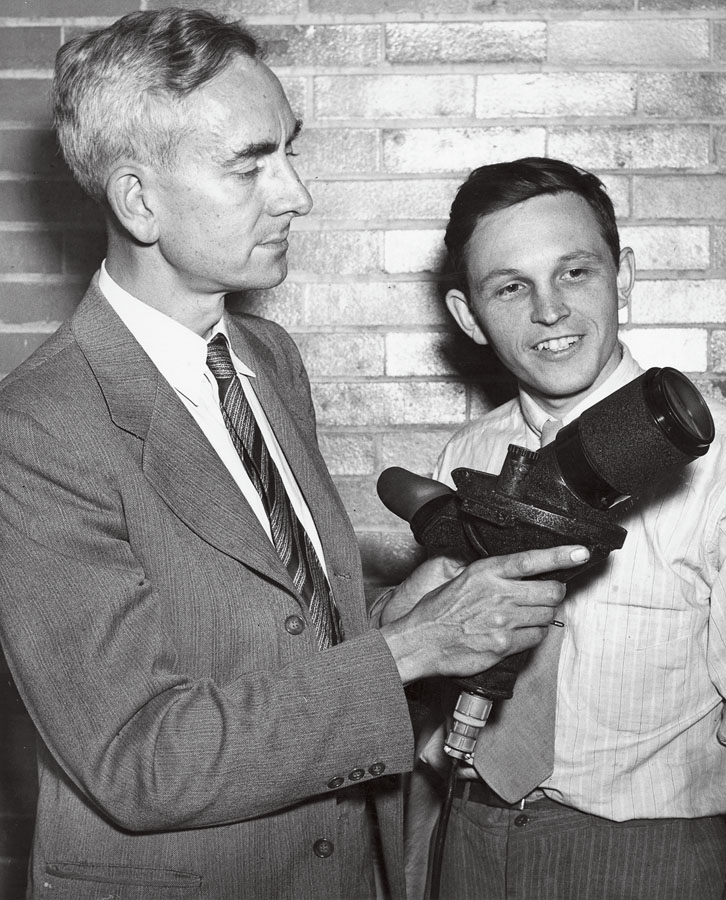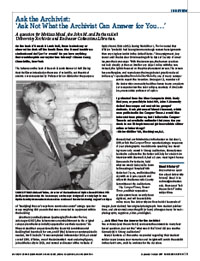In Review
 SUN SETTINGS: Brian O’Brien, director of the Institute of Optics from 1938 to 1953 (left), helped develop the icaroscope, a telescope designed for studying the sun. Optics faculty demonstrated a modern version of the device during August’s eclipse. (Photo: University Libraries/Department of Rare Books, Special Collections, and Preservation)
SUN SETTINGS: Brian O’Brien, director of the Institute of Optics from 1938 to 1953 (left), helped develop the icaroscope, a telescope designed for studying the sun. Optics faculty demonstrated a modern version of the device during August’s eclipse. (Photo: University Libraries/Department of Rare Books, Special Collections, and Preservation)Need History?
Do you have a question about University history? Email it to rochrev@rochester.edu. Please put “Ask the Archivist” in the subject line.
On the back of Bausch & Lomb Hall, there is a balcony or observation deck off the fourth floor. Was it used to address students and staff, or for events? Do you have anything that would explain our mysterious balcony?—Shawn Casey, Churchville, New York
The balcony on the back of Bausch & Lomb Memorial Hall (facing Hoyt Hall) was intended as the scene of scientific, not theatrical events. It was requested by Professor Brian O’Brien for the purpose of “study[ing] the sun’s rays from sun rise to sun set” using a spectroscope weighing 800 pounds that was connected to equipment within the building.
Like the ivy on the Eastman Quadrangle (Rochester Review, July-August 2017), the balcony was an embellishment to the original campus plan that was initially opposed for aesthetic reasons. “Dr. Rhees stated that unquestionably the Bausch & Lomb Memorial Building had been built for use, and if [the] balcony as contemplated is needed, it will be built.” It was completed in November 1930, at a total cost of $891. O’Brien, one of the University’s most enduring figures, joined the faculty in 1930, and served as director of the Institute of Optics from 1938 to 1953. During World War II, Review noted that O’Brien “probably had been given more tough research assignments than any single scientist in the United States.” One assignment, top secret until the October 1946 meeting of the Optical Society of America, was the icaroscope: “With the icaroscope, the human eye does not look directly at the sun itself or any object in line with the sun. Instead, the light is focused on the phosphorescent screen. The screen has an afterglow, and reproduces the image but at greatly reduced brilliance,” reported the Honolulu Star-Bulletin, one of many newspapers to report the invention. On August 21, members of the University community had the chance to use a modern icaroscope to view the solar eclipse, courtesy of Jim Zavislan, an associate professor of optics.
I graduated from the River Campus in 1960. Early that year, or possibly in late 1959, John F. Kennedy visited the campus and met with a group of students. I took pictures of him at the event, which were published in the Campus-Times. I would like to locate those pictures, but I believe the Campus-Times is not available online for that year. Can you check to see if the pictures might be available either online or in hard copy? —Richard Miller ’60, Washington, D.C.
Kennedy had a whirlwind day in Rochester on October 1, 1959, which the Campus-Times reported using a sequence of your photographs. In addition to speaking to a standing-room-only crowd in Strong Auditorium, Kennedy was booked to address the Rochester Ad Club, for a television interview with Channel 10, had a 3 p.m. meeting with area Democratic Party chairs, held what we would today call a town hall meeting at Temple B’rith Kodesh at 7 p.m., and finished the day with an 8 p.m. speech and rally with the Democratic County Committee at the Auditorium.
The Campus-Times, Tower- Times, and their respective predecessors have recently been digitized, and will be available online soon. The University Archives holds thousands of images, but relatively few original photographs from student publications, and always welcomes the gift (or loan) of images in any format—photographs, negatives, slides, and digital.
. . . Ask What You Can Answer for the Archivist
The Archives (and the Archivist) can locate the answers to many fact-based questions, but not the “what was it like” kind: did you see the Kennedy(s) in Strong Auditorium?
Many thanks to all those who responded regarding their student- soldier experiences; your memories and insights will enrich the exhibit in the short-term, and the Archives for the duration.

